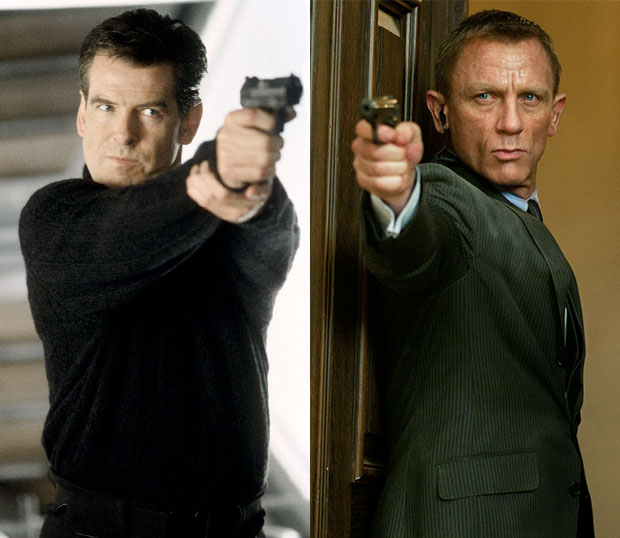
This article contains major spoilers for the latest James Bond film, Skyfall.
There are many earmarks that tend to recur with the appearance of a new James Bond movie. Outside of theme songs, martinis, and beautiful women, new Bond films are typically marked by the revisiting of previous entries by franchise fans. It’s a cinch that after you see Skyfall this weekend, you’ll crack open the DVD or Blu-ray cases to the older movies on your shelf for a little brush-up. Sometimes that path leads you to the best of the series. Other times you end up sitting through the likes of Die Another Day, thinking somehow the renewed fervor in the character will help absolve the film of some of its faults.
If you happen to watch Die Another Day, widely regarded as one of the worst James Bond films, right after Skyfall, which is already gaining a reputation as one of the best, something rather troubling may occur. A close watch reveals similarities between the two movies. Granted, that’s not to say Skyfall was influenced by Die Another Day, but it’s hard to ignore some of their shared DNA. What becomes readily apparent is that the small kernels of quality in Die Another Day that barely glimmer from under its pall of ineptitude are extracted, polished, and perfectly utilized in Skyfall.
Both Die Another Day and Skyfall start off with the conceit that James Bond has been out of active duty for some time. Pierce Brosnan’s Bond was captured by the North Korean military and tortured for fourteen months while Daniel Craig is shot, falls from a bridge, and enjoys a reprieve from his hectic espionage occupation while he’s declared dead. In both films, 007 believes he’s been betrayed, no small personal crisis for that character. Die Another Day only examines Bond’s incarceration and torture (what should be his darkest hour) for the length of a theme song. Skyfall takes the time to establish how the time away, and the perceived betrayal by his own government, takes a toll on him.
In both films, once Bond returns, he must undergo rigorous evaluations to ensure that he is in fact fit to return to fieldwork. In Skyfall, this translates to a series of physical exercises, tests of marksmanship, and psychological assessments. Die Another Day, on the other hand, slaps together a flimsy story device about a virtual reality training scenario in which MI-6 under attack. This only further demonstrates Die Another Day’s wanton abandonment of anything resembling tangible reality and its overuse of silly, effects-driven gimmicks. Skyfall opts for a more basic and grounded approach, a function of the gritty realism of Craig’s Bond films.
Just as in that virtual reality scenario in the final Brosnan Bond outing, MI-6 does actually come under attack in Skyfall. Not only do we get an explosion in M’s office, but also one of the conference chambers becomes the site of an assassination attempt and a massive gun battle. In both films, we are dealing with an enemy harboring a grudge against MI-6. Colonel Moon survived an assassination attempt at Bond’s hands while Javier Bardem’s Silva is nursing a nasty vendetta against M. Like Brosnan’s Bond, Silva was captured and tortured while he worked for British intelligence agency; further fueling the rage he feels toward his former boss.
However, Moon’s revenge plot gets sidetracked by his plan to build a space laser that will take out the minefield separating North and South Korea. Instead of narrowing the plot to something more visceral and interesting, Die Another Day, in a move that will define this entire frustrating movie, goes as over-the-top and absurd as possible. This would almost be forgivable if they weren’t also wholesale stealing plot points from Diamonds Are Forever. There is also the fact that where Bardem plays his villain with a frightening biblical wrath, Toby Stephans plays his like a poorly drawn cartoon.
Die Another Day and Skyfall are the two movies in the franchise that most clearly nod to the legacy of the franchise. In the former, Bond wanders in to the office of the new Quartermaster, the ill advisedly cast John Cleese, to find recognizable props from previous movies lining the walls. He even directly notes a few of these props, including the briefcase featured in From Russia with Love and the jetpack from Thunderball. Meanwhile, in Skyfall, Bond takes the classic Goldfinger Aston Martin out of storage, with all its spy accoutrement in tow. The younger version of Q also makes reference to the goofiness of an exploding pen; obviously referring to GoldenEye. Whereas Skyfall weaves its homage to the golden era of Bond into its narrative, Die Another Day randomly scatters artifacts on the wall like a T.G.I.Friday’s. It’s not hard to see why one feels reverent and the other desperate.
These similarities in basic structure between Skyfall and Die Another Day actually highlight the divergent results of their proper and improper applications. This phenomenon trickles down to several other parallels. They also share things like the use of an underground MI-6 facility (more functional in Skyfall), the starring of an African-American actress in the lead female role (Naomie Watts acting circles around Halle Berry), and even variations on the Bond gun barrel sequence. Die Another Day adds a bullet flying toward the screen when 007does his famous turn, which seems then to suggest that his shot has the benefit of science-defying accuracy. Skyfall simply places it at end as a loving coda. So again, every similarity actually serves to prove that not all Bond films are created equal.
[Photo Credit: Sony Pictures (2)]
More:
The Ending of ‘Skyfall’ and the Series Future — SPOILERS
Adele, ‘Skyfall’, and the State of the Movie Soundtrack
Steamy Romance or Crazy Action: Which Was Harder for the ‘Skyfall’ Bond Girls?
From Our Partners:





